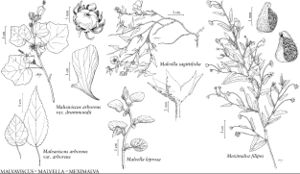Meximalva filipes
Bol. Soc. Bot. México 35: 32. 1976.
Plants 1–1.5 m. Stems distichously branched, stellate-hairy, hairs ferruginous, 1 mm diam. Leaves: stipules equaling or exceeding petioles; petiole 1–3 (–5) mm; blade discolorous, 2–5 (–8) cm, apex acute, surfaces densely stellate-hairy abaxially, sparsely hairy adaxially, hairs simple. Pedicels capillary, often equaling or exceeding subtending leaves. Flowers: buds nodding; calyx 3–4 mm, rounded basally, surfaces ferruginous stellate-hairy; petals 4–6 mm, glabrous throughout (including claw); staminal column purplish, 2–2.5 mm, apically antheriferous; anthers yellowish; styles purple, glabrous. Schizocarps 5 mm diam.; mericarps 2.5 mm. Seeds 1.7 mm, subglabrous. 2n = 16.
Phenology: Flowering spring–summer.
Habitat: Arid shrublands
Elevation: 50–500 m
Distribution

Tex., Mexico (Coahuila), Mexico (Nuevo León), Mexico (San Luis Potosí), Mexico (Tamaulipas)
Discussion
Meximalva filipes is very reminiscent of the widespread Sidastrum paniculatum, differing from that primarily by its solitary, axillary flowers each subtended by a reduced leaf and its non-reflexed petals. In the flora area, it is known from scattered areas of central, southern, and southwestern Texas.
Selected References
None.
